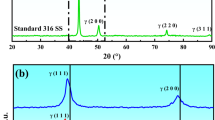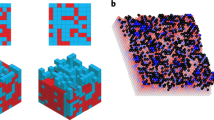Abstract
METALS and alloys which are resistant to corrosion usually depend for their resistance on the formation and maintenance of thin films (commonly between 5 and 200 Å thick) of passivating oxide. The breakdown of such films by “aggressive” anions such as chloride, at sufficiently positive anode potential and at sufficiently high temperature, is often responsible for the failure of such alloys, because it usually leads to serious pitting of the bared metal.
This is a preview of subscription content, access via your institution
Access options
Subscribe to this journal
Receive 51 print issues and online access
$199.00 per year
only $3.90 per issue
Buy this article
- Purchase on Springer Link
- Instant access to full article PDF
Prices may be subject to local taxes which are calculated during checkout
Similar content being viewed by others
References
Evans, U. R., Bannister, L. C., and Britton, S. C., Proc. Roy. Soc., A, 131, 367 (1931).
Hoar, T. P., and Evans, U. R., J. Electrochem. Soc., 99, 212 (1952).
Kolotyrkin, Ya. M., Corrosion, 19, 263t (1963).
Leckie, H. P., and Uhlig, H. H., J. Electrochem. Soc., 113, 1262 (1966).
Hoar, T. P., Mears, D. C., and Rothwell, G. P., Corros. Sci., 5, 279 (1965).
Hoar, T. P., Corros. Sci., 7, 341 (1967).
Author information
Authors and Affiliations
Rights and permissions
About this article
Cite this article
HOAR, T., JACOB, W. Breakdown of Passivity of Stainless Steel by Halide Ions. Nature 216, 1299–1301 (1967). https://doi.org/10.1038/2161299a0
Received:
Issue Date:
DOI: https://doi.org/10.1038/2161299a0
This article is cited by
-
Concerning the stability of seawater electrolysis: a corrosion mechanism study of halide on Ni-based anode
Nature Communications (2023)
-
Study on magnetic pulse crimping process for joining large-diameter aluminum alloy tube/magnesium alloy shaft
The International Journal of Advanced Manufacturing Technology (2023)
-
Effect of Vacuum Pressure on the Initiation and Propagation of Pitting Corrosion of 2205 Duplex Stainless Steel in Concentrated Seawater
Acta Metallurgica Sinica (English Letters) (2022)
-
A review on the corrosion fatigue strength of surface-modified stainless steels
Journal of the Brazilian Society of Mechanical Sciences and Engineering (2021)
-
Computational insights into the corrosion-resistant alloying elements on Fe(110) surface
Journal of Materials Science (2021)
Comments
By submitting a comment you agree to abide by our Terms and Community Guidelines. If you find something abusive or that does not comply with our terms or guidelines please flag it as inappropriate.



